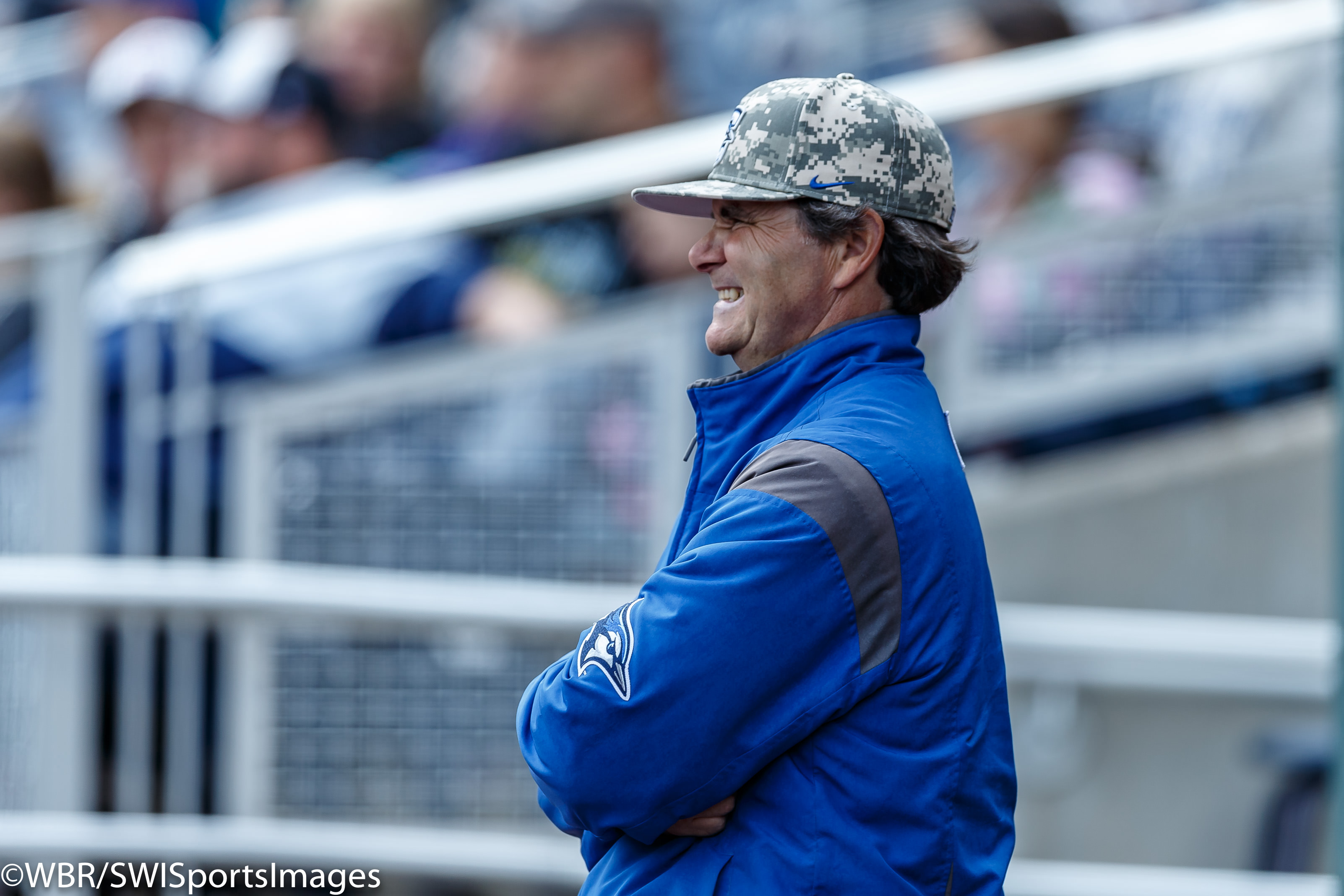At its core, college baseball is flawed.
Flawed because of the allowance of a 35-man roster, of which only 27 players are eligible for the 11.7 scholarships that every D1 team is capped at. Flawed because the revenue that’s earned falls far short of the money spent by any given institution. Flawed because of the obvious advantage public state schools have over their private school counterparts. Flawed because it allowed players to be drafted into the professional ranks while they were in the throes of seeking a national title.
Yet with all its flaws, there’s a great beauty in the game, and that’s not lost on Coach Ed Servais.
This will be his 18th season as the head coach of the Jays and his 36th season coaching baseball. He’s seen the game grow from a niche afterthought in the collegiate sports world to the steadfast behemoth it is now, with games routinely splashed across the various streaming services during the season, and according to Baseball America, pulling nearly 2 million viewers for each game of the 2019 CWS Finals.
He’s also seen Creighton move from a college baseball powerhouse of the Missouri Valley to the much weaker Big East, and the challenges that come with that. When he could put together a winning season and make the tournament field without a MVC title before, he now is forced to win the Big East title to secure a spot.
Servais has found solace in committing to growing and developing players at Creighton. It’s why he’s passed up opportunities in the professional ranks. “I think my style is a little bit better suited for the college game. I like to teach a lot, I like to develop young guys. I also care about our guys and how they do in the classroom, I like to see them graduate. I want to see them be successful after they leave Creighton,” Servais said, “the pro game is a little bit more cutthroat. It’s a little less development and a little more managing of egos and those kind of things. I think I learned a long time ago that I’m better off being a teacher and a developer. I’m happy at the college level, I haven’t really thought two days about it even though my nephew Scott (Servais) is with the Mariners and we’ve had a lot of discussions about it. We talk about the differences and I kind of shake my head every time we talk, reassuring me that I’ve found my spot. This is where I belong.”
The proof exists on the periphery of professional baseball. Dotting the coasts and mainland you’ll find a bevvy of players that have branched out from the program. Some have made it to the show – Nicky Lopez, Anthony Bemboom, Ty Blach, and Pat Venditte, to name a few – yet others are still trying to get to that next level. “That we have 27 players playing professional baseball this summer and only two were drafted out of high school,” Servais said, “I think that says a lot about how we can help these guys develop if they allow us to.”
It’s a game that has so many moving parts, yet Major League Baseball seems to have finally decided to get a stake in the game. With the looming cuts to over 40 minor league programs – most of them rookie ball or single-A affiliates – there seems to be a trend pointing towards collegiate programs assisting with the development of future MLB players. This isn’t lost on Servais, either, and he sees the potential there.
“I think Major League Baseball is starting to realize that, like the NFL and college football, that the NFL uses college football as their minor league system. I’m not saying we’re quite to that level yet but notice the rapid pace in which players get to the big leagues now compared to years ago. I think MLB is willing to help a little bit in funding these expenses that we have at the college level… they’re finally acknowledging that there are a lot of good things happening at the college level. Some of these college coaches know what they’re doing in developing players. If you really study college baseball closely, how many college coaches have been plucked, and are now coaching at the minor league system or the big league level? Wes Johnson – the pitching coach from Arkansas – going to Minnesota. They did a good job. There’s several other college coaches that have had interviews with major league teams. The relationship is better, there’s always been kind of this rift between college baseball and Major League Baseball and I think it’s getting better. The MLB thinks, “Ah, you know, they use the aluminum bat, it’s a different game,” and they’re finding out that’s not the way to look at it. I’m encouraged by what’s going on. I think we need to get the MLB more involved. I think it’ll reduce some of the costs that we have. We need to take advantage of it.”
There are more elements at work here, too. The possibility of funding coming from the MLB is would be huge, especially if they’re willing to follow the Title IX protocols and help fund softball as well. The two sports are intertwined, as they’re both extremely costly to the universities that fund them. According to a 2017 report from the NCAA, softball and baseball generated roughly $565,000 in revenue during the 2016 fiscal year. Stack that with the 3,116,000 that it costs to operate the two and you’re looking at a pretty substantial financial crater, giving schools less incentive to invest in the two sports.
With the MLB’s help in offsetting some of these costs, it’s possible to see more growth and less detriment, which is a net positive for both. Without the funding, it wouldn’t be surprising to see a lot of schools abandon the two sports.
Despite that, Servais believes that the number of scholarships needs to change as long as the institution is willing to foot the bill.“Well they need to change [sic] and I think they will eventually. Now whether they go up to 15 or 20 or 22 – I’m not sure what the magic number is – the popularity is going to force schools to do something about it. I think the coaches in the ABCA are going to force administrators to look at that. I don’t know the ins and outs of Title IX and how it balances – I’m not an administrator – but I believe there will be some changes relatively soon. Because of the popularity, TV ratings, and the amount of games on TV now, it has changed dramatically over the years – and word’s trickling out to the folks who follow baseball that, when you watch these young people on TV, they’re not fully scholarshipped – some of these guys are taking 20-25,000 a year in debt to play college baseball. It doesn’t make sense to a lot of us, so I think there will be some positive changes, just how quickly and how many scholarships is the question.”
Then there’s the issue of recruiting a player to a private school, where the cost of attendance is far greater than their public counterparts. It’s no secret that attending Creighton will financially set someone back much greater than attending Omaha or Nebraska, and that can offer quite a few challenges. It’s why the Big East struggles as much as they do – how do you convince a top of the line ballplayer to attend St. John’s instead of Rutgers? How do you tell a kid that he’ll have a more prosperous baseball future at Georgetown instead of Maryland? Butler instead of Indiana? When there’s so few scholarships, the chips get stacked, and a decision becomes easier for a kid to choose.
“When you have a price tag that we have versus a pricetag of a public school, it’s – yeah – it’s there,” Servais said, “There’s no denying it. It’s something you have to overcome. I don’t think the general public understands that. In other sports you’re either on full scholarship or you’re not. Volleyball you’re either on full scholarship or you’re not. Men’s and women’s basketball you’re either on full scholarship or you’re not. We’re in an interesting situation so we have to work with that. We have to deal with the draft. We have to deal with the drafted players out of high school. We have to deal with players leaving after their junior year. It is a constant challenge when it comes to recruiting, but we’ve really been able to hang our hat on developing players.”
Football has 80+ scholarships. Basketball has 13. You can field two-to-three deep at every position in both sports, yet the time in the weight room and the time spent practicing isn’t all that different. Baseball can reasonably field one team with two pitchers on full scholarship. That’s about it.
The balance in coaching is no different. Where you have multiple paid assistants for a basketball or football team, baseball sits at just two. At Creighton, it’s Eric Wordekemper and Connor Gandossy, who do a lion’s share of both teaching and recruiting. Paul Weidner, the current volunteer assistant, can’t assist in recruiting. He runs camps for the University and is able to collect compensation for that, but doesn’t earn money other than his own means outside of that.
The absence of a third paid assistant has become a hot-button issue in the NCAA. Schools were allowed to vote on whether to allow a third paid assistant to be available, but a great deal of conferences joined together to vote it down, much to the chagrin of baseball-forward schools.
First thing people have to understand is the coaching staff would not get bigger. It’s not like you’re going to get a third assistant and then a volunteer. The only thing different would be the volunteer would be paid through the university and not through camps and some of the other means the volunteer uses to try to make a living. It’s just wrong. Simply wrong. We have 35 man rosters with three paid coaches,” Servais said. “With recruiting the way it is right now, as challenging as it is, as demanding as it is, since it’s year-round, what you’re seeing is college baseball is that this will get passed eventually. It may take two years and then you’re going to see like basketball you’re going to see a guy on the road pretty much all year – that’s your recruiter. He won’t be at a lot of games, he’ll miss a lot of practices, but he’ll be out there doing what he needs to do in the spring and the summer to recruit the players you want Now the volunteer, obviously, can’t recruit. It limits your opportunities to send a guy out when you only have a couple (coaches) at practice. It hurts the young coaches who are trying to develop. I don’t know how some of these guys do it. We all went through it. I wasn’t a volunteer coach but there were a lot of years where I didn’t have a lot of resources and you were creative in what you did, but it discourages a lot of what I think would be good coaches to get into the profession because they realize, “You know what, I can’t live 2-3 years on this kind of salary or just making camp money or doing lessons. I have to have the benefits, I have to have something else.”
Servais went on, expanding on the topic.

Coming to Creighton to play baseball is a lot more costly than other schools especially with the sport having limited scholarships (Spomer / WBR)
“It’s wrong. I think it’s going to get corrected. I’m not sure why it was voted down. I’m not an administrator and I never will be one. I don’t know exactly why the reasoning is for it because if we adapted it doesn’t mean each institution has to do it. It then becomes an institutional decision, just like not everybody who plays division one baseball is fully-funded scholarship-wise. Every institution has to make that decision. I don’t like the fact that we’re trying to drag everybody down. Let schools who really believe in what they’re doing and are willing to do it, do it! But let’s not drag this down because there’s some institutions out there that don’t think they can fund it. Let everybody make that decision on their own.”
Being in the Big East has its challenges. With just seven teams competing for a title each year – soon to be eight with the addition of UConn – there’s little room for rainouts and cancellations. There’s been talk over the years even previous to UConn’s arrival, to expand the conference schedule to allow for a 24 game schedule, with a rotating opponent that a team would play twice every season. This would aid in solidifying teams who are deserving of the conference tournament and those who aren’t.
Beyond that, the Big East has tried to be creative in their scheduling, even going as far as having an early season conference tournament at a neutral site.
“Things become a lot more interesting with UConn joining. I suggested that we go with a 21 game schedule the first two years because it’s going to be unbalanced a little bit. We’re going to have four home games, four home series one year, three home series the next year. I think it should go through that schedule one time. There was a lot of coaches interested in having a 24 game conference schedule where we will meet somewhere at the beginning of the year – maybe the first weekend in April or the last weekend in March – go to a neutral site, whether it be in Florida or wherever, and have two pods set up where Creighton would play team A, B & C, so everybody would get three games in that situation. It’d be based on the previous year’s standings. I wasn’t a fan of that initially. I don’t necessarily like neutral site games. I don’t like games where you don’t have a chance to take batting practice before the game, where you just roll out there and play. Not these games, at least. These games, as we found out two years ago, are very important. I’m glad UConn is joining our league – that’s huge. They’re a good baseball program and it’s going to be a really tough 3 game series when you play them. It already gives the Big East a little more cred amongst baseball people. If 21 games isn’t enough, ideally we’d have three more, but I don’t like this other format, but I know the first year UConn is in the conference it’s going to give us 21. It may only be one year and we may jump to 24 in 2022.”
Regardless of college baseball’s flaws, its unfair regulations, and the lack of scholarships and support, it will still rage on this year and all the years after. It’ll stand the test of time, just like Coach Servais, and it will endure an immense amount of change. What we see today will likely look entirely different 10 years from now, and it shall persevere, warts and all.
Creighton baseball opens the 2020 season this weekend with a three-game series against Seattle University, starting on Friday afternoon at 2PM.






